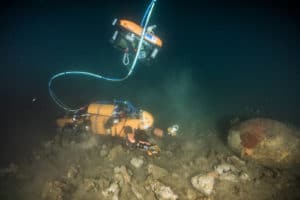Robots in deep waters
With their articulated hands enabling them to grasp objects, robot archaeologists are pushing back the limits of underwater exploration. The team that dived into Toulon harbor in mid-April was a strange one: a 3-meter, 180-kilo colossus followed by a more discreet companion.

Their names: Ocean one and Léonard. What makes them special? They're robots. Revolutionary robots that push back the limits of exploration and precision underwater work.
For Ocean one's first outing, the robots dived in Toulon harbor, on the wreck of the Lune. This warship of Louis XIV's fleet sank in 1664, taking with it weapons, crockery and the crew's personal effects, precious witnesses of a bygone era that lie 90 meters below the surface. A treasure trove for archaeologists. And a challenge for researchers: "At depths of over 50 metres, wreck excavation by divers becomes too dangerous and complex", explains Vincent Creuze, researcher at the Montpellier Laboratory of Computer Science, Robotics and Microelectronics (Lirmm).
The first underwater humanoid
Ocean one is the world's first underwater humanoid. With its three-fingered hands, the Stanford University robot is able to pick up precious, fragile objects from the seabed and bring them to the surface, without breaking them. A delicate operation made possible by revolutionary "haptic" technology, which enables the robot's pilot to feel the pressure exerted on his metal hand, translating the "sensations" perceived by the robot's arm.
During its dive, Ocean one was assisted by the Léonard robot, entirely developed by Lirmm. Its mission: to support the humanoid's umbilical cord, avoiding the disruptive effects of marine currents and providing the pilot with an overhanging view.
A fruitful collaboration that heralds a new era for underwater archaeology, which will now be able to explore ever deeper wrecks.